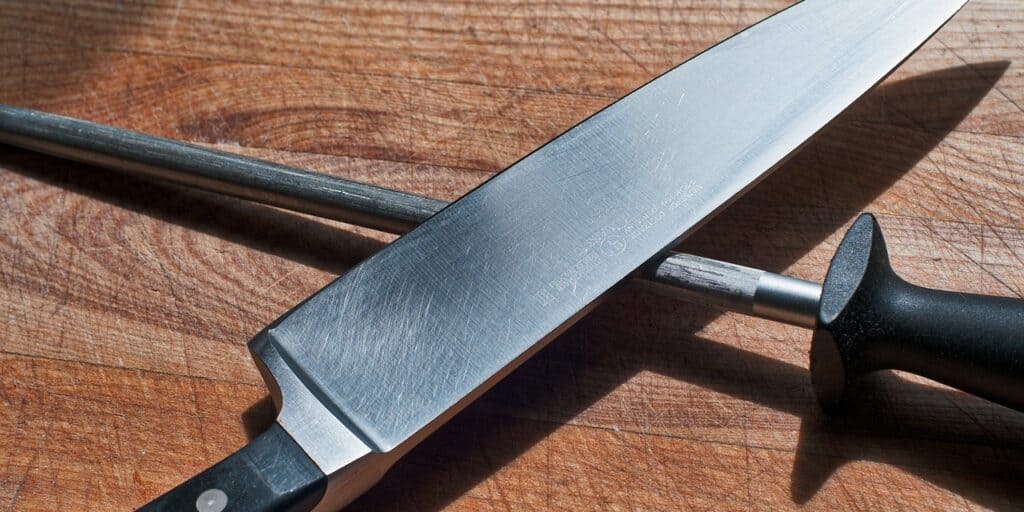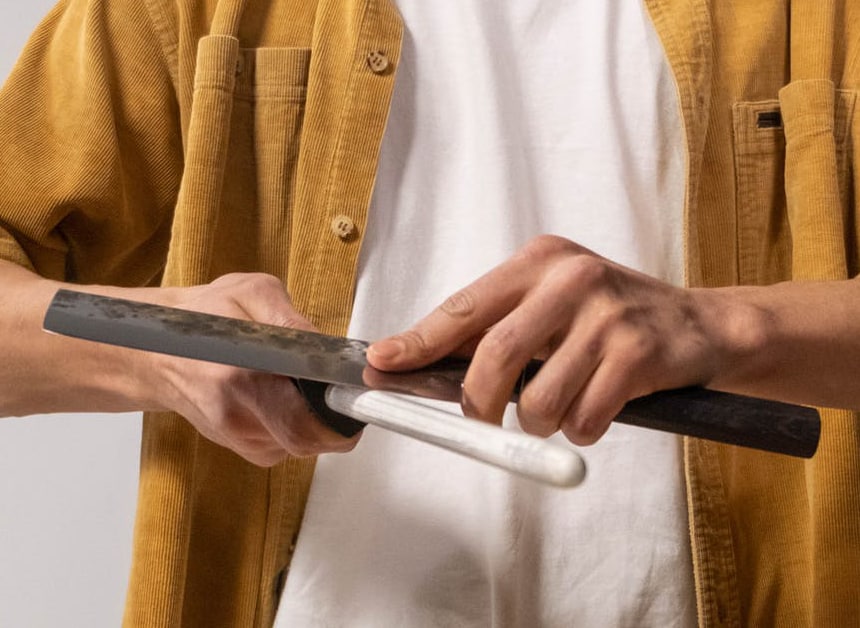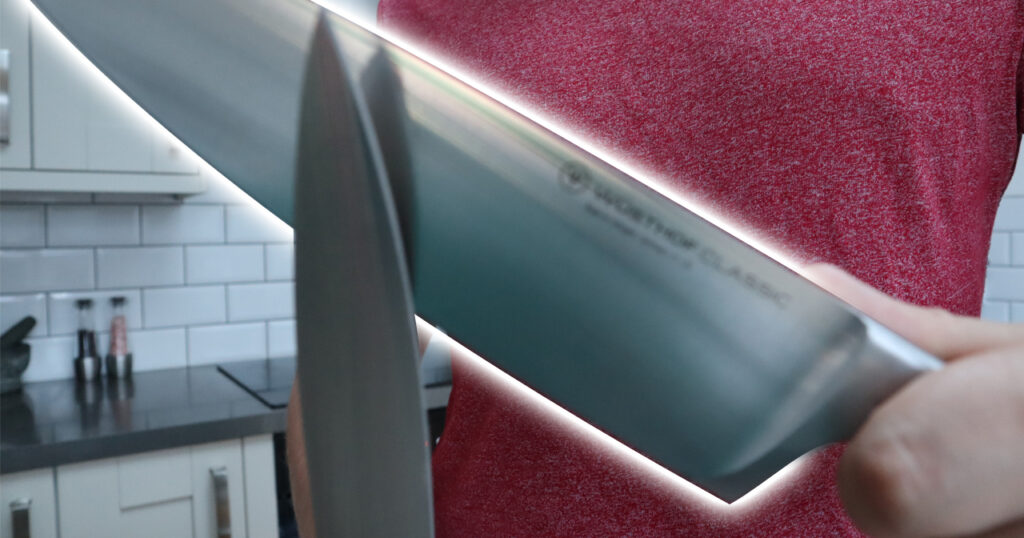
Your kitchen knives are hands down the most important tool in your kitchen. There probably isn’t a single meal you make where a knife isn’t used during its preparation (we’re not taking ready meals here! … Although you still usually need to pierce the plastic cover, so even then..).
Most of us use a knife almost every day, and it can be pretty easy to become complacent with them. With every use the knife gets more and more blunt, slowly, day by day it’s losing its sharp edge. It can be almost unnoticeable if you’re using it every day but eventually if left unsharpened your knife will be far less effective than it was.
This doesn’t only make it more difficult and time-consuming to chop slice and dice in the kitchen, it’s also a hazard. A blunt knife is harder to control, the edge is much more likely to slip off food and not cut straight, and so a blunt knife is always more dangerous than a sharp one.
Thankfully there are many different methods we can use to sharpen our knives. Some are more intense and time-consuming but there are also some methods which are super quick and easy. In this article, we’re going to look at all the most common ways people keep their knives sharp.
I’ll take a look at the process needed for each one, the pros and cons of each method, as well as showing you some of my favourite sharpeners for each method
The concept of sharpening
First, it’s important to do a quick overview of what you’re actually doing when you sharpen a knife as this is often somewhat confused.
Sharpening a knife is the process of using an abrasive surface to remove a layer of the steel particles from the knife blade. Essentially you’re removing a layer of the metal to reveal a new fresh, and sharp one below.
This is different from honing a knife. Honing rods are often mistakenly thought to be for sharpening knives. Honing rods do not sharpen knives, although they are important. We’re going to talk a bit about honing at the bottom of the article, but first, let’s begin by looking at each of the methods for sharpening a knife.
I’m going to list these in what I believe to be their order of difficulty, with the most difficult first:
- Whetstones
- Sharpening rods / sharpening steels
- Pull through sharpeners
Whetstones
Whetstones, otherwise known as waterstones, are the most effective way to create a super sharp edge to your knife. They are also the best way of repairing a knife which may have become chipped and damaged.
However, using a whetstone is the most difficult technique in this article. That being said, if you follow the principles using a whetstone you can become quite adept quite quickly. It will only take a 5 – 10 minute practice for you to be good enough to sharpen your knives effectively.
What are whetstones
Whetstones are an abrasive flat stone used to sharpen your knife. Its heritage is Japanese and whetstones are the recommended sharpening method for Japanese and carbon knives. They are used let so to sharpen the western style stainless steel knife but they are still extremely effective at doing so.
How abrasive the stones are is known as their grit. That’s the same terminology used to measure the abrasiveness of sandpaper. The higher the grit the finer the surface of the whetstone is.
A lower grit such as 240, would be used to remove a larger layer of the knife blade, likely because it has been chipped and damaged. Generally, you’ll be able to nicely sharpen your knife using a 1,000 grit stone. You can get extremely fine whetstones of 6,000 grit which is used to add a fine polish to the edge.
Next, let’s look at how you should use a whetstone.
How to use a whetstone
Whetstones are also known as waterstone, and for good reason. Whetstones are porous and they need to be thoroughly saturated with water before you use them to sharpen your knife. Place the whetstone in a tub of water for around five minutes, you’ll know that the stone is fully saturated as the air bubbles will have stopped coming out for the stone.
You will want to prevent the stone from moving whilst your sharpening. Some whetstones come with their own hold which will do the job, but if you don’t have one you can easily use a wet kitchen towel or some wet kitchen paper to place on a table underneath the stone, this should hold it in place fine.
You can place the stone in any direction you like, the most common ways are to have the stone facing perpendicular to your body or horizontal to your body. However, many chefs will have to lay their stone at a slight angle as they find it easier, so just go with what feels natural.
You now want to find the correct angle for your knife. Japanese blades and carbon knives can be sharpened at a smaller angle, whilst Western, stainless steel knives need a larger angle. Generally, you should follow the below guidelines but your knife manufacturer may also state the exact angle of the blade:
| Knife type | Sharpening angle |
| Japanese/ carbon knives | 12-15 degrees |
| Western style / stainless steel knives | 20 degrees |
Finding the angle might be tricky. The video below explains the whole process of sharpening using a whetstone extremely well. The whole video is worth watching but if you skip to 1 minute 20 seconds you can see a nice little tip for finding the correct angle easily.
Essentially if you put the knife blade down then the knife is at 90 degrees, tilt it to halfway you’re at 45 degrees, half again and you’re at around 20 degrees (ideal for a Western style knife). Half it again at you’re at around 12 degrees (ideal of a Japanese knife).
Once you’ve found the angle, starting with the tip of the knife on the stone, push forward and along the blade, sharpening the whole edge. Do this a few times on one side and then turn the knife over and repeat.
You’ll notice a build-up of grey water on the stone, that shows the process is working. You’ll want to keep the stone wet throughout so add a little water to the surface of the stone now and again and continue.
How long you will need to repeat this process depends entirely on how blunt or chipped your knife was at the start. If the knife was only a little blunt then a few minutes on a 1,000 grit whetstone will do the trick. If it was chipped then you’ll need to spend some time on a 240 grit stone first and progress to a 1,000 grit which could take 10-15 minutes in total.
There is always the option of increasing the grit past 1,000 if you want a really fine edge to your blade, so if you’re really into maintaining the best possible edge give it a go.
Which whetstone should I buy
I would recommend having a range of 240 – 6,000 grit whetstones. Luckily whetstones often come with a different grit on each side so you don’t actually need that many.
The SHAN ZU Knife Sharpening Stone has a two-sided grit of 1,000 and 6,000 as well as a beautiful holder. It’s a great product for the price, you can take a look on Amazon here.
The Richardson Sheffield sharpening stones offers a two-sided grit for more damaged blades with a 240 grit and 1,000 grit. You can take a look on Amazon here.
Sharpening rods
The second most skilful sharpening method is sharpening rods. These might be a bit more familiar than the whetstone, they are a long solid rod which you would hold in one hand.
What are sharpening rods
The rod is made of extremely hard material. The rod needs to be stronger than the knife blade it is sharpening, otherwise, you would just be removing layers from the rod with the knife, rather than removing layers of the knife with the rod.
Because they need to be so strong, sharpening rods are made from two types of materials.
Diamond sharpening rod – Not quite one big diamond (unfortunately), but diamond sharpening roads have a diamond-encrusted surface along the rod. Diamond is so hard that I would not advise using a diamond sharpener on Japanese or carbon knives, they are so brutal in their abrasiveness that they can be a little too harsh for these types of knives. They are better used on western style stainless steel knives.
Ceramic sharpening rod – Ceramic is an extremely hard material, harder than steel, and so ceramic rods are the second type of sharpener. Although extremely hard, ceramic is quite brittle and dropping one of these could actually cause it to snap in two, so be careful.
How to use a sharpening rod
There are two ways you can hold a sharpening rod whilst using it. One way is freehand, where you hold the knife in one hand and the rod in another without any support. The second is by holding the rod vertical against a hard surface such as a tabletop.
Holding the rod vertical gives you more control and helps you keep the correct angle as it is easier to stop the rod from moving.
You should angle the blade of your knife against the rod at between 12 and 20 degrees depending on the type of knife you have. As we have already mentioned, we would not recommend using a diamond sharpener on anything other than a western-style stainless steel knife, but you may be able to use a ceramic sharpening rod on a Japanese or carbon knife.
| Knife type | Sharpening angle |
| Japanese/ carbon knives | 12-15 degrees |
| Western-style/ stainless steel knives | 20 degrees |
Start with the hilt end of the blade against the sharpening rod and pull the knife back and down against the rod.
Alternate from side to side for five to ten strokes, or more if the knife is particularly blunt.
This video has a great demonstration of how to sharpen a knife using a sharpening rod:
Which sharpening rod should I buy
The Wusthof ceramic sharpening steel is a great choice, high quality with a fine rod. You can check it out on Amazon here.
This Wusthof Extra Fine Diamond Sharpening Steel is also a great choice, you take a look at it on Amazon here.
Pull through sharpeners
Pull through sharpeners are the most simple of sharpeners to use. They give you less control than a whetstone or a sharpening rod but they are suitable for most home chefs and they can be used to sharpen your knives very quickly.
What are pull through sharpeners
Pull through sharpeners come in many variations however the principle stays the same. Two fixed abrasive sections create a V shape sharpener. The knife blade is run through the sharpener and the blade is sharpened from each side at the same time.
Just the same as sharpening rod, pull through sharpeners must be made of a material harder than the steel blade. You’ll find pull through sharpeners made from:
- Diamond
- Ceramic
- Carbide
I would only recommend using pull through sharpeners on western style stainless steel knives. You shouldn’t generally use a pull through sharpener on Japanese style or carbon knives, the angle will usually be wrong and some of the sharpeners, especially diamond ones, can cause damage to these types of knives. There can also be a difference to how pull through sharpeners actually sharpen knives, creating a slightly serrated edge on the knife rather than the smooth sharp result of using a whetstone, this is not suitable for Japanese and carbon knives.
However; I will add the caveat that you can buy specific sharpeners designed for the intended use of sharpening Japanese and carbon knives only, so if you are going to use a pull through sharpener on one of those, make sure it is suited to the task.
How to use a pull through sharpener
Using a pull through sharpener is easy. Start with the hilt end of the knife blade placed between the V of the sharpener, don’t push the knife down with too much force. Then pull the knife towards you until the whole blade has been sharpened.
Repeat this around five to 10 times and the blade should be sharpened, if you started with a particularly blunt blade this may take a little longer.
Which pull through sharpener should I buy?
The Wusthof 2-Stage Pull Through Knife Sharpener is a great option. It’s best used for western style knives and has two sharpening options. Check it out on Amazon here.
How often should I sharpen my knife
You don’t need to sharpen your knife very often. For general home use, you shouldn’t need to sharpen your knife any more regularly than every six to twelve months. If it’s a knife which you use infrequently then you can probably get away with even less than that.
However, to keep your knife well maintained I do recommend that you hone it on a regular basis, let’s talk about knife honing, what it is and why you need to do it.
Honing steels
It’s difficult to talk about sharpening knives without talking about knife honing. The two are so often mixed up but both are really important if you want to maintain your knife properly. Keeping your knife honed is just as important as keeping it sharp, so let’s look at what honing a knife is, how to do it, and what you need to do it.
What is a honing steel
A honing steel does not sharpen your blade because it is not designed to remove the metal from your blade. A honing steel is designed to realign your blade to make the edge smoother. As a result, the blade will slice better, in effect, it will be sharper but honing will not work forever and eventually, your knife will need to be sharpened properly.
When you use a knife the blade edge will always start to go out of alignment. Imagine the edge of a blade as thousands of microscopic teeth. With use those teeth get bent over, using a honing steel will bring those teeth back into place.
Because the blade will go out of alignment after pretty much every use (if only at the microscopic level), you should use a honing steel far more frequently than a sharpener. For general home use, I would recommend honing your knife after every three uses i.e. after every three cooking sessions.
How to use a honing steel
A honing steel can be used in a very similar way as a sharpening rod. For more control of the steel hold it vertical with the end held against a flat surface such as a table.
Start with the hilt end of the blade against the steel at a 20 degree angle and pull the blade down and towards you along the honing steel so that you hone the whole blade at a 20 degree angle.
Repeat this on each side of the blade around five to ten times. Make sure that you hone each side an equal number of times, otherwise, you will push the blade out of alignment towards one side.
How often should I hone my knife
You should hone your knife around every three cooking sessions. This is much more frequent than sharpening which needs only be done every six to twelve months.
Which honing steel should I buy
The SHAN ZU Honing Steel is a beautiful piece of kit and should last for decades. You can take a look on Amazon here.

